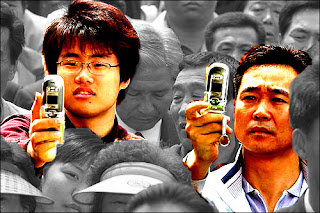.jpg)
This was a relatively plain picture of 2 close friends I personally know, sharing a corn cob. The colours of the picture were changed and enriched via "Image" and "Adjustments" in Photoshop. The "Brightness/Contrast" were altered as well as the "Hue/Saturation" to transform this originally dull photo into one that conveys the theme of friendship more effectively, of friends-turned-sisters on a summer days filled with memories of participating in activities as simple as sharing good food.
Communication:

This was a picture of a mother sharing a special moment with her newborn baby at the hospital. Despite no exchange of words occurring between the two, a connection between them is undeniable. And perhaps, herein lies the core of all communication- that communication at its highest level needs no words or even body language, a facial expression or emotion expressed through the eyes may speak more than a long email. To create this effect, the "Lens Flare" filter was placed between the mother and her baby to emphasise their wordless communication, their faces in particular are also brighter than the other parts of the photo. This was made possible through adjusting "Lighting Effects" in the "Filters" pull down menu.
News-worthy:

With new communication technology, the citizen journalist phenomenon is increasing at a rapid rate. An example of this technology is the mobile phone camera that allows users to take photos anywhere anytime. A group of people as seen in the photo have their attention fixated on something big, perhaps a politician's speech or a car accident. The advent of mobile phone photography has allowed the masses, encapsulated by the 2 holding up their camera phones, to capture news-worthy events such as in the photo without the presence of a professional. These photos can then be placed on blogs to provide first hand accounts of events. This was done similarly for events such as 9/11 in New York and the Indian Ocean Tsunami back in 2004. The effects was created by first cropping the two people with camera phones out and adding a filter effect on to them. The photo was then made black and white which was done through "Image" and "Adjustments" and then changing the "Hue/Saturation." The separate layers of the camera phone holders were then put back into the original photo.
Australian:

This was a photo of a friend on Australia day doing some pretty Australian things. He is standing on the beach, drinking an Australian beer with the Australian flag waving behind and being wrapped by the green and gold Kangaroo's flag himself. All I had to do for this photo to create my desired effect was add an "Artistic," "Dry Brush" filter and making a few little alterations with the filter itself such as the brush size. I think that now rather than only being a photo, it looks more like a painting to be put in a time capsule that provides a snapshot of what's "Australian" in our day and age. A good Aussie beer, our history, our rich natural landscape and our sporting culture are just some the things represented in this photo.
Popular:

This a a beautiful photo of the popular tourist location, Ayers Rock. From history as we know it, Ayers Rock has always been there, evolving from being an important place to the Aborigines to somewhat of an Australian icon today, yet Ayers Rock itself has barely changed! Rather, it is our perceptions and discoveries over time that have altered what is considered popular and when in our culture. Something that is truly great such as the sun or Ayers rock as depicted in this photo is however, timeless. Again with this photo, the "Hue/Saturation" was changed to give the original image an almost magical feel to it. Rather than having a front on perspective of Ayers Rock, having the landmark on the side gives it a rather majestic sense of it I think. To enhance this, the right side of the photo where the Rock sits was dimmed slightly through adjusting the "Brightness/Contrast" of that part of the photo. To accentuate the sunlight hitting the beautiful Australian landscape surrounding Ayers Rock, the lighting was altered slightly in between the horizon and the ground again through "Lighting Effects" under the "Filters" menu.
Games:

Chess has been a game played for centuries but yet still popular among many today. Games, from the dawn of time, have been used for fun and recreation. Characteristics of good games however, have not changed and include being easy to understand, challenging and fun. The classic game of chess to me encapsulates all these ideas and conveys strongly the idea of 'games.' This simple photo is equally timeless as the hand moving the pieces could be anyone from essentially any era of time after the early invention of the game. To create this effect, the photo was made black and white through changing the "Hue/Saturation" in Photoshop. Blurring effects was also applied to certain parts of the photo, such as the upper and lower portions, to increase focus on the hand and the pieces its moving. This has the similar effect as taking the photo with a wide aperture to increase the visual focus on a particular subject.





